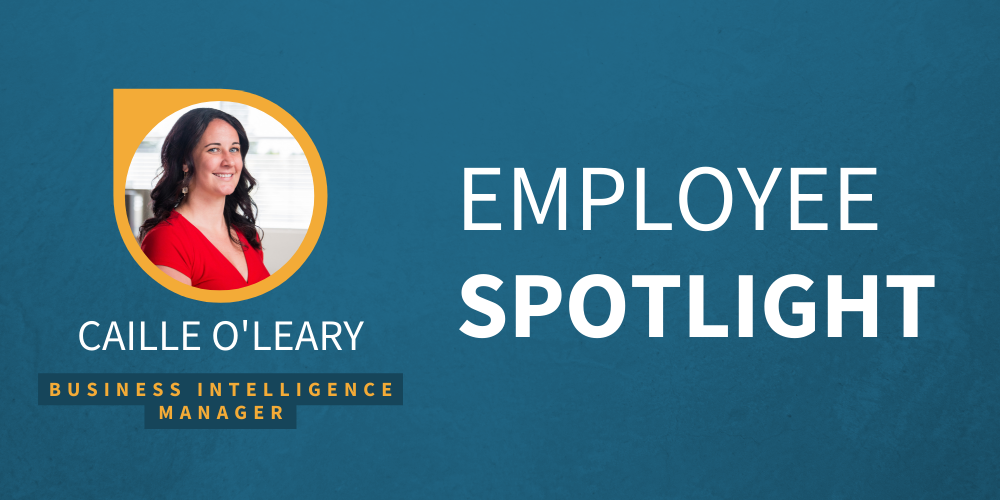
Scale Your Video Production or Sink
The B2B landscape is relentless, and mediocre video production won’t cut it. Learn why scaling high-quality video production is essential to drive ROI, stand out, and stay competitive in today’s paid media game.

Informed data empowers organizations to reach their goals.
Our Closed Loop Business Intelligence Manager, Caille O’Leary takes pride in helping clients reign in large data sets into actionable insights. Learn more about Caille’s passion for numbers and her tips for creating an internal data-driven culture.
I never want to look back and feel that I’ve led a boring or “safe” life. I am a calculated risk-taker and thrive when I am in an environment of constant learning and stimulation.
Life is incredibly short, and it’s very important to me to learn and experience as much as possible.
As technology and our ability to gather more data grows, data literacy should become a staple in education, including elementary schools. There’s never been a time like this where massive volumes of data have been available to us.
I live in downtown Sacramento, so I love taking advantage of the dining and nightlife scenes and all of the awesome events throughout the year, especially Kings games.
Traveling is also a big part of my life. I try to go away at least for one weekend every month 1-2 bigger trips a year. I am also a runner. I finished my first full marathon in 2019, but I generally run at least one race a month, whether a trail run, obstacle course, or road race.
From an external point of view, I love it when something I contributed to becomes a client win.
For example, we could have worked hard to put together a new report and gather insights for a client. And because of that, the client gains the confidence to increase their budget by $50,000. Or, it can be a moment when we get positive feedback from a client about our team.
I love seeing those types of things happen. I take pride in when the work I do contributes to our client being pleased with our organization.
The other piece that makes me tick is that I’m wired to be a problem solver. When I go into each engagement, there’s a mystery to be solved. I enjoy investigating, identifying and resolving issues. My insights and reporting assist our ad managers in helping our clients reach their goals. I love the dopamine rush I get when figuring something out.
I was looking for a workplace environment supportive of their employees, an organization not hesitant to give you the things you need to succeed. They give you the tools and resources you need to make work life easier.
I was also looking for an organization with growth opportunities. In my past roles, I’ve reached the top per se, where there was no room for me to grow professionally.
When I first arrived at Closed Loop, my position was a first of a kind. There was no such thing as a data analyst or BI manager. When I started, I was able to take this role and create my vision for it. Fast forward today, I now manage a BI team.
This organization also embodies flexibility, support and potential for growth. When I interviewed here, I knew I would be constantly challenged.
I get to work with people who continually push me. I never want to work somewhere where I feel like I’m the smartest person in the room. Smart, capable people surround me. I’m always inspired.
Remote work at Closed Loop is easy.
I have a quiet, peaceful work environment at home. Even working remotely, we communicate well with each other on Slack.
I never feel detached. Everyone here is a good communicator. We’re always talking to each other. We also use tools like Zoom several times throughout the day. It’s nothing to hop on a quick Zoom call to go over something or answer a question.
We have many tools at our disposal, and everyone uses them well. Being well-connected makes remote work effortless.
There’s not a typical day for a business intelligence manager. I’m doing a lot of different things depending on what the day-to-day needs are. I handle client-side reporting requests, which include gathering and extracting data to build out reports.
I also manage data infrastructure needs, meet regularly with ad managers, stay on top of our clients’ ever-evolving needs and ensure all reporting reflects that.
Currently, the big internal project I’m leading involves transitioning our technology to assist us with the data extraction portion of our data pipeline process.
Data is everywhere, and everybody is using data for everything. The amount of data available to us continues to grow exponentially. Gathering information is just one priority. It’s also essential to be able to effectively clean, analyze and interpret what it means.
You can have large sets of information. However, data becomes useless if you still don’t know what to do with it or have the skill set to look deeper than the surface and extrapolate meaningful and actionable information.
As technology and our ability to gather more data grows, data literacy should become a staple in education, including elementary schools. There’s never been a time like this where massive volumes of data have been available to us.
We’ve seen in recent years, including this pandemic, numbers being thrown out about “percent chance of this” or “this percent effective.” Many people struggle to understand what these numbers mean. There’s been a misinterpretation of data due to not having a foundational knowledge of these concepts.
Data and statistics are pervasive in our world now. It’s not just the workplace, but it’s out there in our everyday world. Taking in this information given to us and understanding the meaning behind statistics that affect our lives makes data literacy even more important.
One of the advantages we have here is we’re able to marry together our front-end advertising data and the data the client receives in their backend, as far as lead generation. With this transparency, we gain full-funnel visibility into our clients’ advertising paths.
This visibility into deeper metrics gives us the ability to granularly slice and dice data.
We provide our clients with solid, actionable insights so they can optimize their campaigns to generate leads and maximize their advertising spend efficiently. Gathering, cleaning, analyzing and interpreting their data allows us to help them get the most bang for their buck.
The lack of clean backend data, proper tracking and marketing technology stack are common pitfalls I notice across clients.
Sometimes clients will capture advertising information through an URL, and that URL gets passed through two to seven different marketing platforms before. We have to sort through that and ultimately generate some data to tie back into their front-end advertising data.
Often, we’ll also see clients only capturing bare-bones information. The scenario may be like we know this data comes from Google, but we don’t have anything beyond that.
That’s kind of useful for us, right? But, what we really want is to get as specific as possible. The lack of capturing specific information and dirty data requires us to clean it up a lot. Those are the two major pitfalls I see.
Every client is different. Some of them come to us with pristine data, and others come to us with no data. We’ve seen scenarios where they haven’t even set up their Salesforce campaigns to be able to capture anything.
We ultimately gauge where the clients are in their data journey. What kind of resources does the client have? How big is their organization? Do they have an analytics team? Do they have a development team that can make these things happen? Do they need to outsource? Are they limited in time? Are they limited in expertise?
On a client-by-client basis, we take time to understand their unique needs and tailor our services accordingly.
We bridge what’s technically going on under the hood and how that is communicated to clients and stakeholders. That’s the role of business intelligence.
Many organizations have a significant amount of data available to them and want to see it all. Just because you have the data doesn’t always mean you can do anything actionable or useful with it.
It’s essential to lock in on your key KPIs—the things important to your organization and what will drive growth. Avoid including items that are just nice to have or nice to see. There’s not a lot of value to those necessarily. Less is more.
Stick to the fundamentals you know—your primary growth KPIs that will ultimately help you achieve goals.
If there’s no reason to add different colors, segments and filters—then, don’t add them. Often, people requiring reporting are executives who simply want a 30-second snapshot.
Keeping your dashboards clean and less convoluted makes communicating and conveying the essential things to driving outcomes easier.
Embracing data throughout your organization helps you be more effective with that data. Data literacy should be paramount in all roles across the company, not just your BI or data analytics team.
Working to cultivate a data-driven mindset internally makes it easier for everyone to understand, communicate, analyze and act on the available data.
Here at Closed Loop, all ad managers take routine Tableau training to build their knowledge. And because of that, they continue to maximize meaningful, actionable data for our customers.

The B2B landscape is relentless, and mediocre video production won’t cut it. Learn why scaling high-quality video production is essential to drive ROI, stand out, and stay competitive in today’s paid media game.

Misaligned metrics and fragmented strategies aren’t just inconvenient—they’re costing your marketing team revenue and results. Explore the root causes of data chaos and learn how to align your metrics for paid media success.

AI tools promise automation and efficiency, but without human expertise in creative, strategy, and oversight, they amplify inefficiencies. Learn how to balance AI’s strengths with human intervention to drive results.